
My in-ground vinyl pool is 28 years old. During this time, I have only needed to replace my pool liner one time. In earlier times, I ran a small home daycare of three children with 12 years between the youngest and the oldest. I was the only mom who did not go to a regular 9-5 job, so my house became the neighborhood daycare. Needless to say, my pool received a lot of use during those years.
Today’s liners are not the same as they were years ago. They used to be made with certain chemicals that were banned. I cannot remember what this chemical was, but the EPA said that it can no longer be used in vinyl liners and other vinyl products. Certainly something that was not good for us anyhow. Although the newer type of vinyl may not last as long as vinyl liners made in the ’80s, a replacement in-ground vinyl liner can still last 20 years, if you take care of it.
Below are the things I have done to my pool to get the longest possible life out of my pool liner.
6 Ways to Increase a Pool Liner’s Lifespan
1. No Non-Pool Toys! Probably the most important thing is only allow pool toys in the pool. I cannot begin to tell you how many calls a day I take during which the customer says their liner ripped. When I ask what happened (I always do), nine out of 10 times, the kids had skateboards, swords or Barbie dolls in the pool. Needless to say, these toys are not meant for the pool and usually cause holes in the liner. Shoes and street clothes should also be banned from the pool.
2. Balanced Pool Water! I think the second most important thing would be water chemistry. Water chemistry is extremely important for the health of the pool water, as well as the pool liner. Your pool pH should be between 7.4-7.6. pH actually measures the acidity or alkalinity of the water. If the pH is above 7.8, a scaling condition results, which can cause calcium to cloud the water, mix with dirt, and deposit itself on the liner. If the pool pH is too low, this can cause vinyl liners to start wrinkling or puckering. Low pool pH is very acidic and corrosive, and it literally sucks the life out of vinyl liners. The low pH of chlorine tablets, coupled with acid rain, or acidic plant debris, can reduce your pH level, below 7.2. Be vigilant and watchful, and add pH increaser to keep the pool pH in the 7.4-7.6 range. If you have problems with making your pH adjustments stick, check the total alkalinity level and adjust it to a range of 80-120 ppm.
3. Careful with Chlorine! Another major problem is the very harsh chemical chlorine. If chlorine (shock or tablets) comes in contact with the liner, it can bleach it very badly and slowly eat away at the liner. I always tell people to dissolve their chlorine or shock in a bucket first and then add it to the pool. If any dissolved granules fall in the pool, hit them with a brush quickly. Floating chlorinators, either used during summer or winter, are a bad idea, and so is putting tablets in your skimmer. Do not do it! Install a chlorinator back by the filter, so that chlorine tablets never have a chance to contact the vinyl. Maintain your chlorine level in the range of 1.0 to 2.0 ppm. If you go too high for long periods of time or shock the pool too much, the chlorine level itself can start bleaching and sucking the life out of your pool liner. Keep the chlorine strong enough to sanitize the pool, but not so strong it starts to damage the liner. I have always used Nature2 mineral purifier as long as I can remember, and it has undoubtedly helped my pool liner last 20 years. Nature2 allows me to keep the chlorine level very low, just under 1.0 ppm, and the minerals are much easier on the liner than chlorine.

4. Careful With Cleaning! Making sure you use the proper maintenance equipment for your pool is also very important. You want to make sure you are using a vacuum that is meant for a vinyl liner pool if you have a vinyl liner pool. A vacuum head meant for a cement pool may cause scratching or holes in your liner. The sharp metal ends of your pool pole can puncture the liner badly and should never be put in the water without having some kind of attachment on the end of the pole. I receive a lot of phone calls where people have used the pole to reach a toy. The pole gets heavy, hits the floor and pokes a hole in the bottom. I had one customer once who discovered lots of half moon, crescent shaped rips all over the floor of his in-ground pool, so many that he decided to replace the liner. I later found out from the customer that his teenage kids and friends were using the pool pole to pole vault over the pool; each vault made a nice hole in the liner. I also heard that the kids involved were all drafted into a small pool liner replacement army.
5. Never Empty a Vinyl Pool! If you empty the water out of the pool, an old liner can shrink and crack. It is amazing but if you drop a plate on the floor and it cracks, the same thing can happen with a liner. As they age, the vinyl weakens and becomes very brittle. A lot of people empty the pool to clean the bottom. As much as that sounds like a good idea, I can assure you it is not. Pool liners do not have to be empty long before they start to shrink. You can empty out something less than half, to dilute bad pool water, but always leave 6-12 inches of water over the shallow end floor to keep the liner in place.

6. Take Care of the Waterline! Lastly, take care of the waterline. This is where the sun can do the most damage. If your pool gets a lot of sunlight, I always recommend to go with a thicker liner, and the sun will have to work harder to wear the liner down. I also make sure to wash down the water line area regularly with a vinyl cleaner that protects the vinyl from the sun’s rays. It’s best to have the water level on the low side, so you can apply the cleaner to a larger area. Do not use a household cleaner, which may contain abrasives, chlorine or phosphates. Another problem for waterline areas is a buildup of oily deposits, which can stain and mark your pool liner at the water line. If your pool requires frequent cleaning to remove a scum line, use enzymes like Pool Magic in the pool to consume the oils and keep the liner looking good. If your waterline looks awful, take a look at BorderLines, a stick on the border that covers up an unsightly water line on vinyl pools.
Making a pool liner last 20 years is no easy trick, but it can be done. Taking care of your pool liner is the main thing; you also have to resist the urge to replace the liner just to “update the look,” which is common. You also will probably have to be tolerant of some fading of the pattern, or even a few patch repairs that were made, which also drives many pool liner replacements.
If your in-ground pool liner is showing a little too much of its age, see our other posts on inground pool liner installations. With a few simple measurements, our in-ground pool liners can be on your doorstep in just a few days.
If you want to brag about how long you’ve had your liner or mistakes that led to a new pool liner, share your tips with others. Leave a comment below!

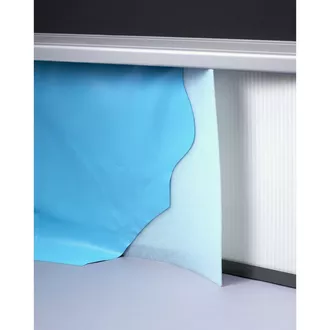

My above the ground pool liner is approximately 23 years old. We have lived in our home for 15 years and have only covered our pool 2 of those years. The liner is completely faded and has sun all day long. I am so worried that it will break while my grandchildren are swimming in it.how do I know if it needs to be replaced?